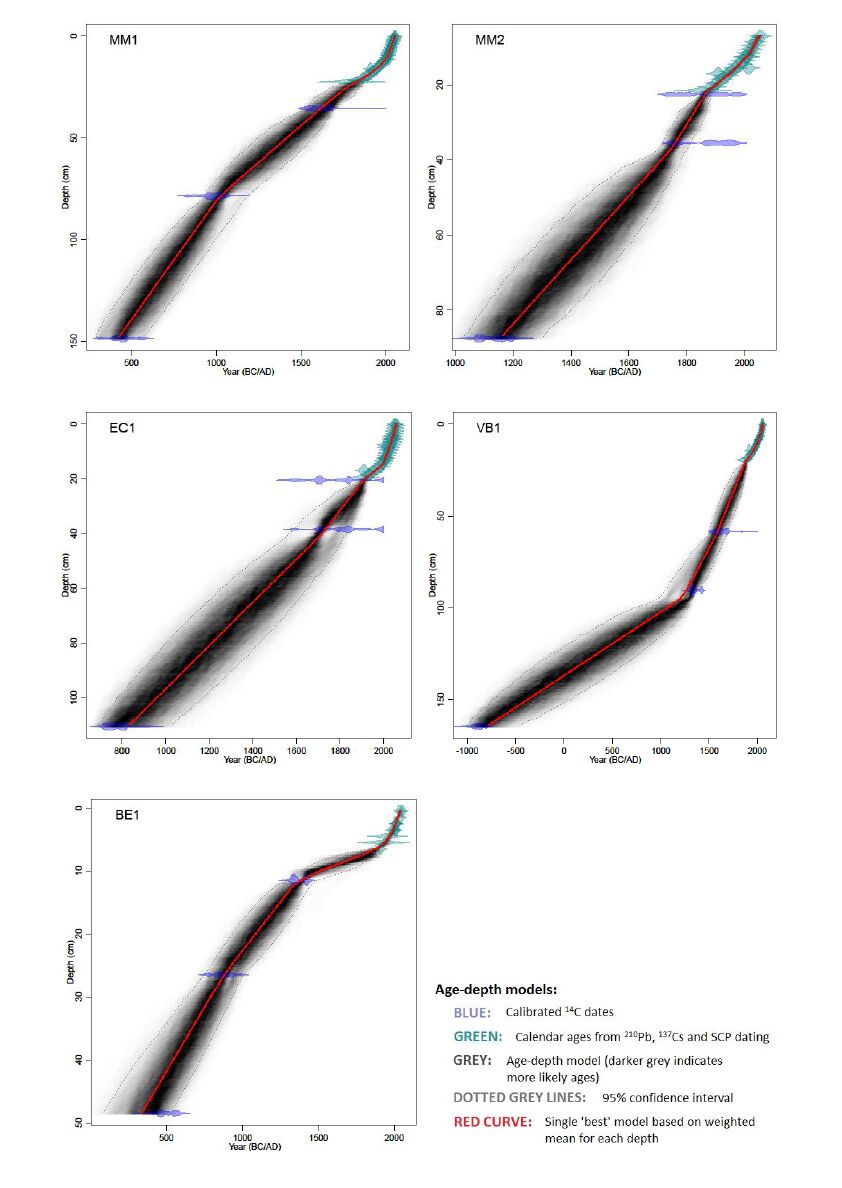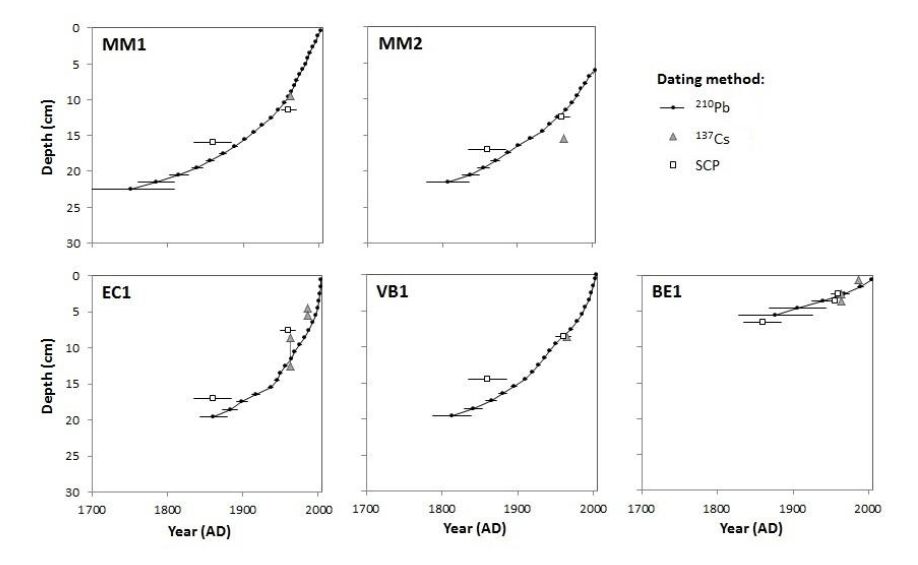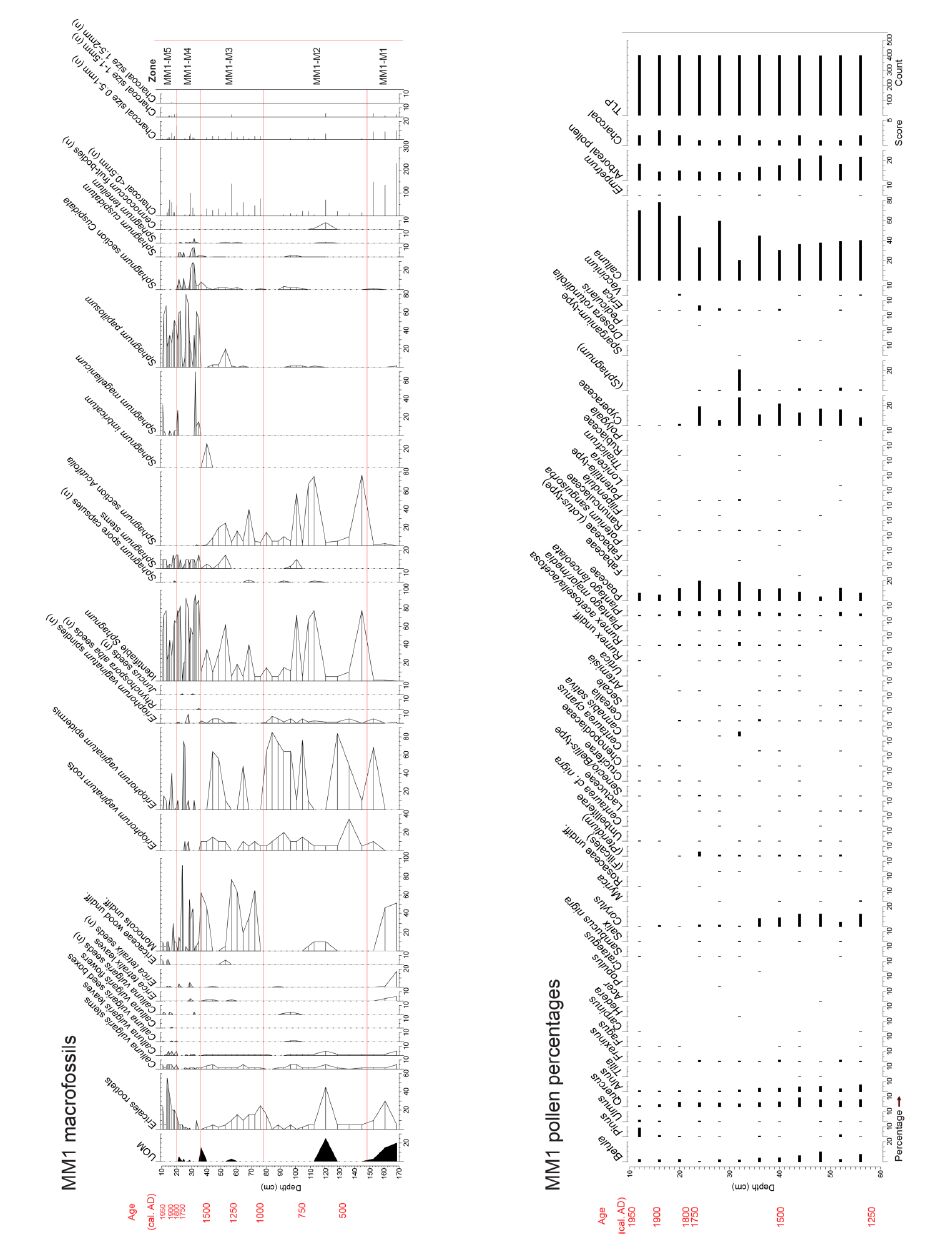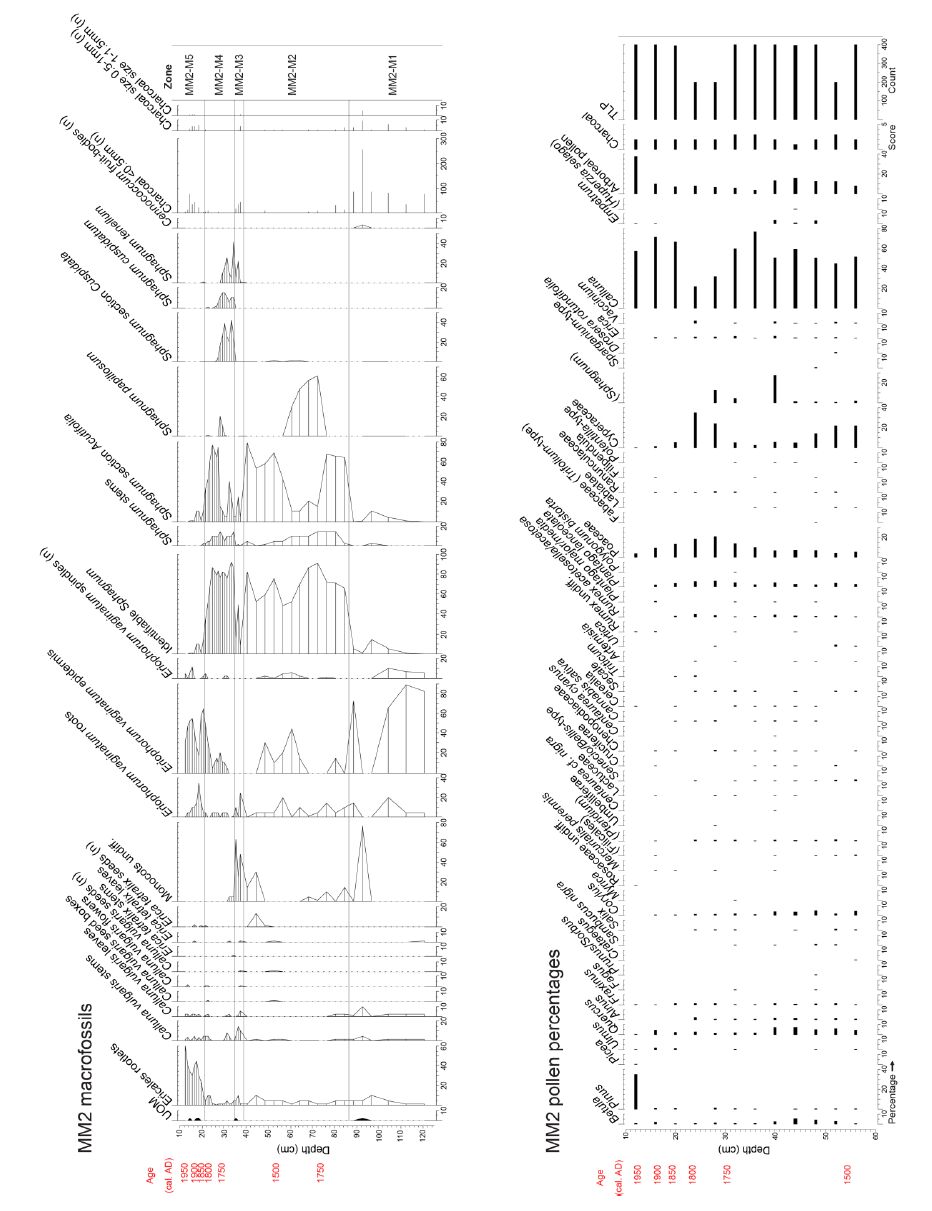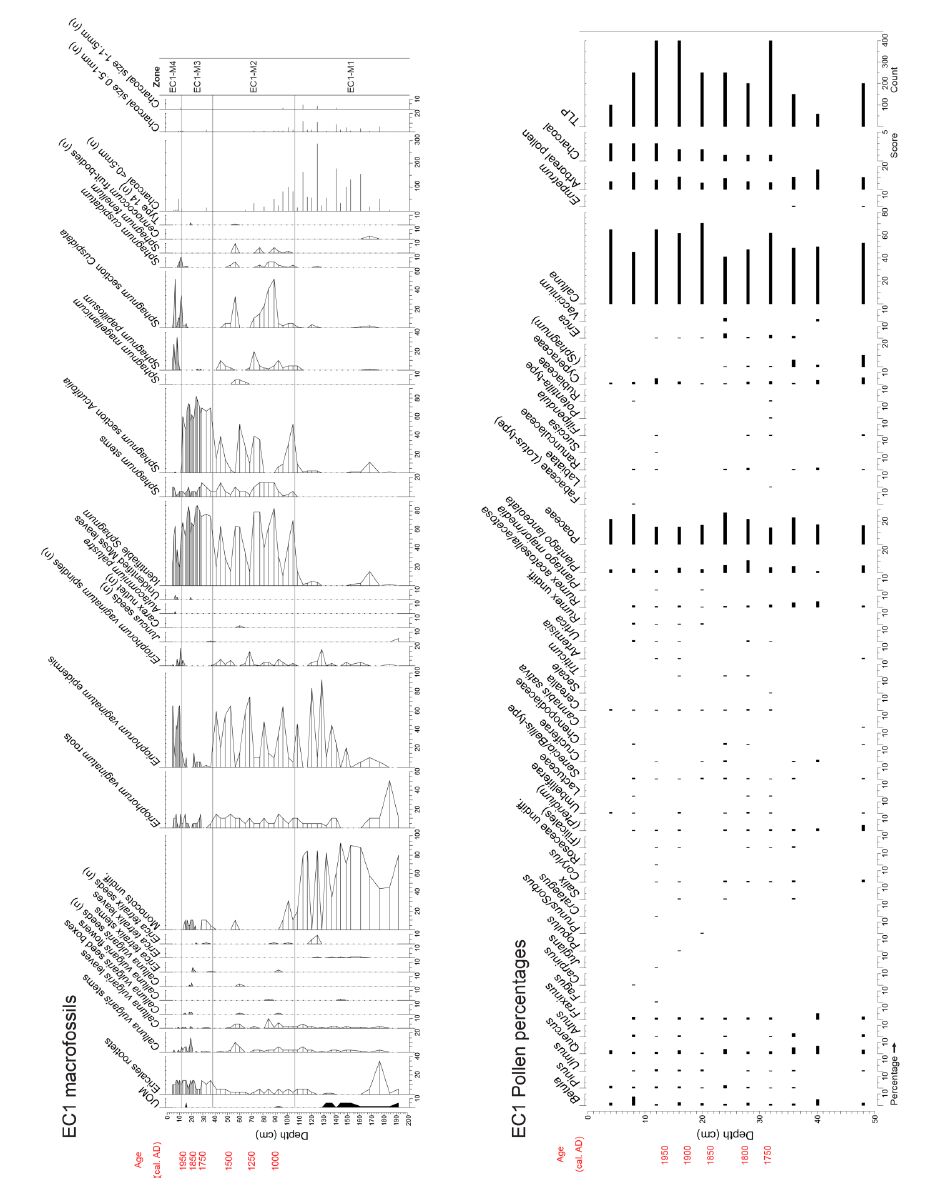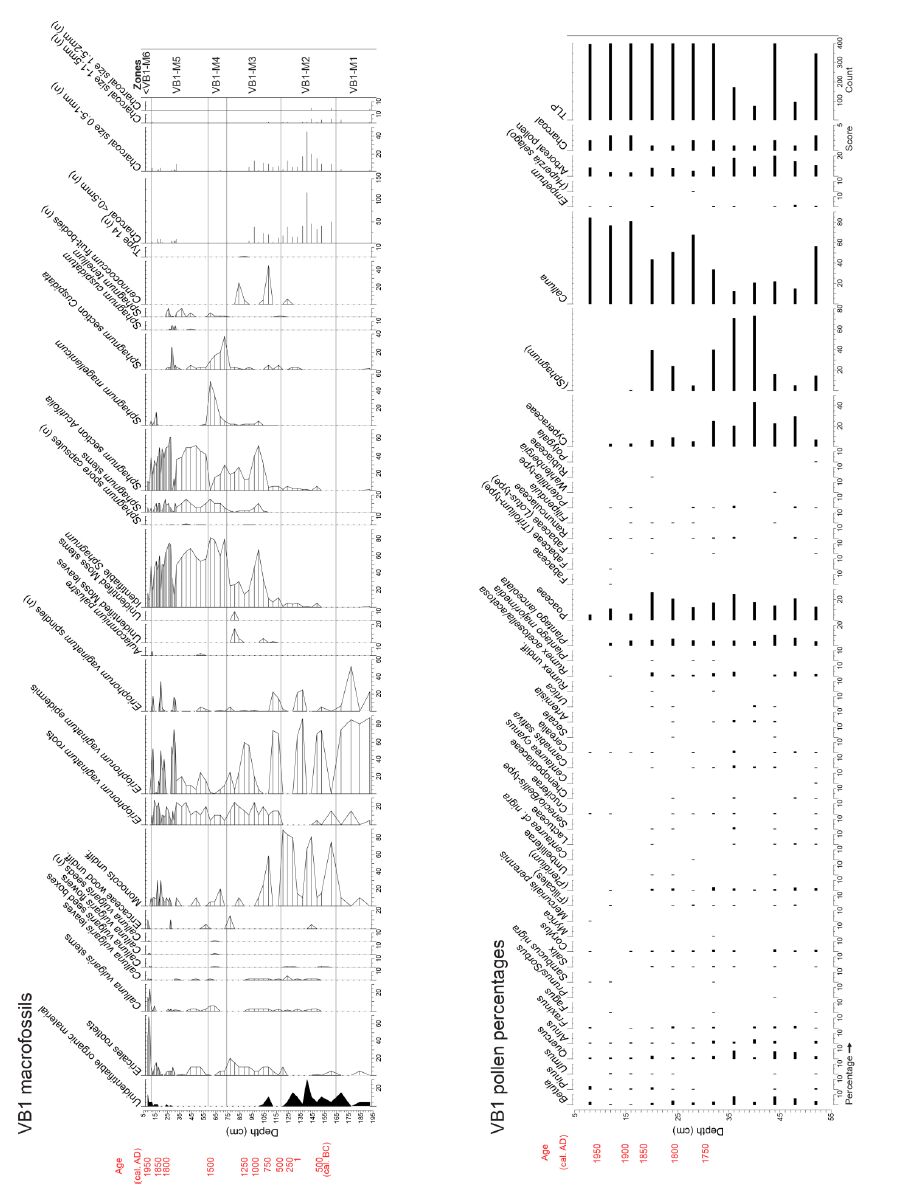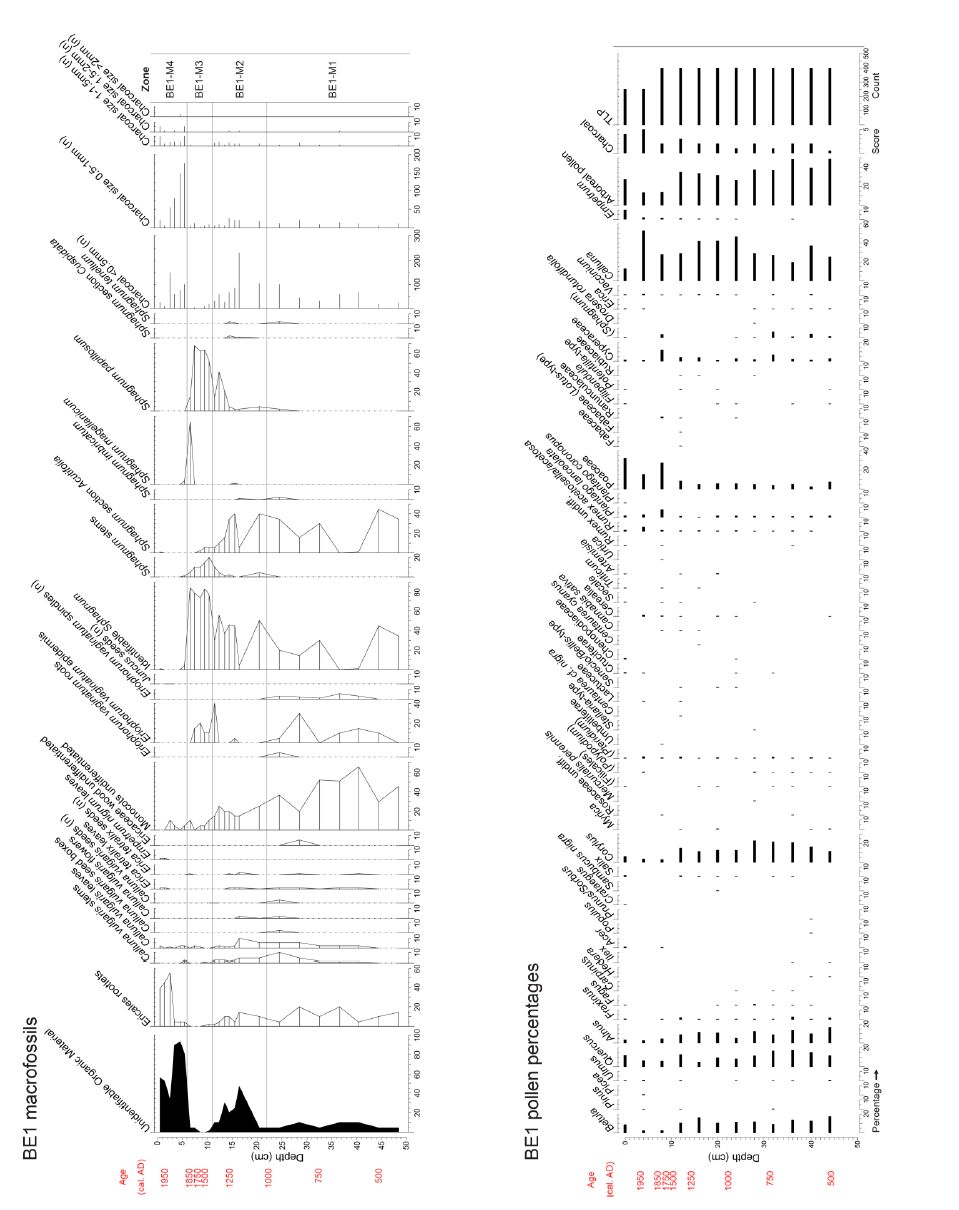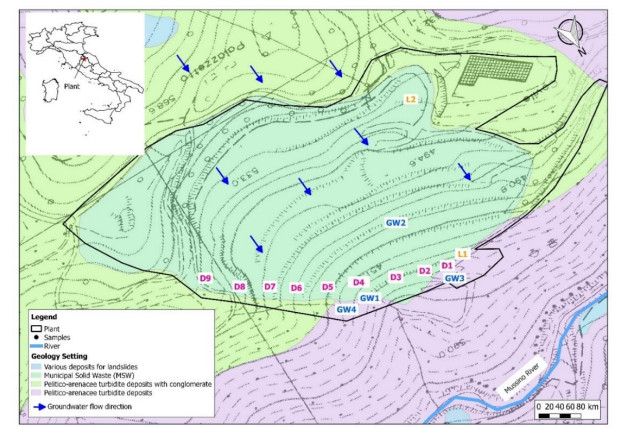1. Introduction
Restoration of degraded ecosystems varies from re-vegetating areas void of vegetation as a result of strip mining, to encouraging selected species in tracts whose vegetation is depleted as a result of one or a range of causative factors. Both initial states are possible for degraded peatlands. These may vary from mined and cut-over bogs, from which vegetation has been removed and peat has been extracted, to intact mires whose vegetation may nevertheless have been affected moderately or severely by grazing, burning, atmospheric pollution, marginal drainage, recreational pressure or other human impact [1]. In Northwest Europe for example, many mires are not in pristine (natural) state, but instead are part of a long-established, cultural landscape that may itself have experienced shifts in cultural pressure [2]. Continued cultural effects over centuries, and/or sudden, major changes to cultural practice may result in these mires being in at least a partly degraded state. This degradation is often, but not always, more pronounced in areas close to major human habitation or industry.
In upland Britain the state of the majority of mires gives cause for concern for statutory conservation agencies, who have had targets imposed by Government for restoration. These targets can give rise to controversy, particularly as many mires serve multiple purposes: as grazing land; as areas for game management, including as nurseries for red grouse (Lagopus lagopus), for shooting; as catchments for water companies; as flood alleviators, through moderating surface run-off; as wild-bird sanctuaries; as areas for hill-walking and recreation; as areas for military training or military establishments; and, more recently, as sites for wind-power generation. In the north of England, controlled burning is carried out as part of the management of some mire and moorland vegetation for driven grouse shooting. Repeated burning of upland moorland can, like lowland heaths, lead to the development of a Calluna monoculture [3]. This can take place on moorland overlaying mineral soils or on deep peat (in conjunction with drainage). Some land-managers consider that sites on deep peat have always been Calluna-dominated, rather than an outcome of management practices such as drainage and burning.
Government-imposed targets for restoration may take little or no account of likely recovery time; or of when, why or how long the mires became degraded. The pre-degraded state is often inferred, based on short-term understanding of mire ecology, rather than on empirical evidence. In Britain, this is by reference to the National Vegetation Classification (NVC), which is in effect a snap-shot survey of observed vegetation from the late-1970s/early-1980s [4]. As this likely took place after most types of mire degradation had taken place, it might not include the full range of pre-degradation vegetation. So, the restoration target might not be representative of a pre-degraded state, or indeed achievable if the timing of the degradation is not fully understood.
It has been suggested [5] that palaeoecology could assist conservation management by providing very long-term ecological data to supplement (by several centuries or millennia) those from ecological monitoring. This is acknowledged in two of the 50 most important research questions (priority question numbers 9, 13) identified in palaeoecology [6]. These questions ask "How can palaeoecological data be used to inform ecosystem restoration, species recovery and reintroductions?" and "How should palaeoecological results be translated and communicated effectively to ensure they are adaptively integrated into environmental strategies for the present and future?".
A palaeoecological study on Exmoor, linked to plot-experimental work by the Heather Trust (a charity that promotes moorland management) to control invasive purple moor grass (Molinia caerulea), showed that an observed shift from heather moorland to dominance by purple moor grass was indeed recent, but that the heather moorland itself had no long antiquity, itself having been preceded by grass moor [7]. Ecological monitoring studies, which seldom exceed a few years, had not shown this; and nor had it been revealed by local oral history, which chronicled the recent shift from heather dominance. Only palaeoecological studies showed that the locality had alternated over centuries between grass and heather moorland, but with a recent rise to dominance by Molinia in the 20th Century. Since this pioneering study [7] in 1999, collaborative studies with statutory agencies, responsible for achieving conservation targets, have been relatively few.
Recognising the potential contribution of very long-term (i.e., paleoecological) data, the (then) Countryside Council for Wales commissioned research to inform decisions over upland mire conservation in South and Mid Wales [8,9,10]. Subsequently, the equivalent agency in England commissioned research to ascertain the timing, nature, direction and magnitude of any recent vegetation change in a range of upland mires in Northern England, from degraded sites in the South Pennines, to less severely affected sites in the North Pennines and North York Moors. Selected data from these sites are presented here, including new age-depth modelling, designed to ascertain more closely the approximate age of major recent vegetation change.
The rationale for this study lay in concern over the effects on moorland of intensification of land use in the English uplands, notably the intensity of grazing and the frequency of burning. The UK Government Public Service Agreement (PSA) target for Sites of Special Scientific Interest (SSSI) originally required 95% by area to be in favourable condition by 2010. However, it became evident that this target was too short-term and not realistic. Many moorland sites in northern England would fail condition assessment, on grounds of species composition or diversity. The overall aim of the study was to investigate, using palaeoecological methods, the evidence for recent human impact on moorlands, so as to understand more fully, when and how the sites had become degraded and from what previous vegetation type(s). Amongst the questions for which Natural England staff require answers are these: how different are environmental conditions today compared with the past; what species were historically found on mire sites; what species have recent dominance or relative abundance; when did this dominance appear; what species present elsewhere on UK sites might be justified for reintroduction on sites where they used to occur but have experienced extirpation. An understanding of long-term vegetation history would then help inform the relevance and viability of national PSA targets and be an important step in developing or revising any restoration programmes. If the results were found particularly instructive, the methods applied could be used elsewhere in the UK and internationally, to inform conservation endeavours.
2. Materials and Methods
2.1. Site selection
Field sites were selected by conservation agency staff, in discussion with scientists from the Centre for Environmental Change and Quaternary Research (CECQR). Degraded sites were identified by single-species dominance of vascular plants, such as heather (Calluna vulgaris); lack of typical mire species, particularly Sphagna; the absence of mire microtopographic features, such as hummock and hollow; and presence of drainage channels. Selected data from five peat profiles are presented here: two from the North York Moors, 100 m apart; a 1-m deep profile from Egglestone Common and a deeper profile from Valley Bog, Moor House National Nature Reserve (NNR), both in the North Pennines; and finally, a shallow profile from Blackstone Edge Moor in the South Pennines (Figure 1). Of these, the two from the North York Moors were from May Moss, adjacent to the Early Warning Station at RAF Fylingdales, from a relatively intact area of peatland; that from Egglestone Common was from an extensive area of relatively depauperate moorland (lacking much Sphagnum); the relatively deep peat profile from Valley Bog, Moor House NNR was in extensive heather moorland; that from Blackstone Edge Moor was from an intact, relatively dry-surfaced upstanding hagg of peat in partly eroded peatland. The mix of site types, peat depths and range of human impacts—such as atmospheric pollution, grazing, and burning by rotation—would help in assessing the potential value of palaeoecological studies for informing conservation in a range of degraded peatland habitats.
2.2. Fieldwork and sampling
Sample points were determined after preliminary stratigraphic investigation using a 1.8 m probe. Sampling was then accomplished either (i) by digging a small pit and inserting a 15 × 15 cm cross-section, three-sided aluminium tin into a vertical face of peat, which was then cut behind using a special peat cutter [11], or (ii) by extracting the first 50 cm using that method, and then coring either beneath or beside, using a Jowsey sampler, the coring following a sampling protocol originally devised for raised mires [12].
2.3. Mineral magnetic susceptibility
Peat generally has very low magnetic susceptibility, and so mineral inputs should be detectable against such a low background figure. The intact cores were scanned for mineral magnetic susceptibility using a Bartington MS2 magnetic susceptibility meter with MS2C core-logging sensor. The purpose was to detect any mineral inwash or aerial deposition, and to help correlate core lengths from the two separate coring points at each cored site.
2.4. Plant macrofossil analysis
Analyses were conducted using the semi-quantitative Quadrat and Leaf Count macrofossil analysis technique (QLCMA) [13] at a minimum of 1-cm intervals in the top 50 cm of each of the sampled profiles, so as to provide a high-resolution record of recent site vegetation history. Samples lower down were spaced at 4-cm intervals to provide a long-term context. A quantitative estimate of charcoal concentrations in different size classes was made when using the QLCMA technique.
2.5. Pollen analysis
This technique was designed to supplement the plant macrofossil analysis conducted on each profile, by providing a wider picture of vegetation change around each site than might be obtained with the potentially profile-specific plant macrofossil analysis. From each peat profile, twelve subsamples of 0.5 cm vertical thickness and c. 1 cm3 were taken and prepared for pollen analysis following a protocol [14]. Pollen was counted at ×400 to a sum of 400 total land pollen (TLP), or until the whole 22 × 22 mm coverslip had been traversed at 0.5 mm intervals. Taxa wholly in parentheses in the pollen diagrams were excluded from the pollen sum. In a few horizons, pollen was so sparse that a representative count was not possible. A semi-quantitative relative estimate (on a scale 1 to 5) of charcoal noted on the pollen slides was made for each analysed horizon, merely for comparison with the principal source of charcoal data produced when conducting QLCMA.
2.6. Spheroidal carbonaceous particle analysis
This technique [15] relies upon recognition of microscopic spheroidal particles produced from fossil fuel burning. Its use was intended to assist in providing a chronology for the accumulation of the upper peat horizons in each profile, as is done for lake sediments, in which the temporal pattern of SCP accumulation has been found to vary spatially, depending on regional industrial history [16]. SCP concentrations are expressed as numbers of particles per gram dry mass of sediment (gDM−1). The diameters of SCPs ranged from 5-30 µm.
2.7. 210Pb dating (alpha spectrometry); fallout radionuclides (gamma spectroscopy)
Lead-210 (210Pb) and other fallout radionuclides can be used to date peat accumulation for the last 150 years [17]. The top 30-40 cm of peat were analysed at the University of Exeter Radiometry Laboratory using alpha spectrometry, which measures the decay of 210Po, a daughter product of 210Pb. A Polonium spike (209Po) was added as a chemical yield tracer, and then Po was extracted from the sample using acid digestion and electroplated onto a silver disc. Ages were calculated using the Constant Rate of Supply (CRS) model [18].
Other fallout radionuclides were measured at the University of Gloucestershire by gamma spectrometry; as also initially was 210Pb, which is included in the age-modelling for site BE1. Potential chronostratigraphic markers result from the peak of atmospheric thermonuclear weapon tests (attenuated by the Nuclear Test Ban Treaty, 1963) and in Central and Northwest Europe the Chernobyl nuclear reactor accident (1986). Theoretically these markers would be represented by two statistically significant peaks in 137Cs data, occasionally accompanied by 241Am and/or 134Cs (further by-products of weapons testing and the Chernobyl incident, respectively) [17,18].
2.8. Radiocarbon dating
The combined analysis of SCPs and 210Pb dating was intended to provide a timescale for the uppermost peat horizons. Lower in the profiles, sub-samples of peat were taken for radiocarbon dating to provide a timescale for earlier vegetation changes. After the SCP, pollen and macrofossil analyses had been conducted, critical horizons were identified in the pollen and macrofossil diagrams below the lowermost incidence of SCPs, and small samples of (bulk) peat of c. 0.2 g were taken for accelerator mass spectrometry (AMS) radiocarbon dating [19]. Beta Analytic Inc, Miami (USA), conducted the dating. A list of dates is provided in conventional years BP in the ‘Supplementary Material'. Dates were calibrated (to years cal. AD/BC) to 2σ using the IntCal13 calibration curve [20].
2.9. Age-depth modelling
The peat cores were dated variously using a combination of radiocarbon dates (14C), 210Pb dating, nuclear fallout radionuclides (137Cs and 241Am), and SCPs. For each peat profile, data were combined into a single, piece-wise linear age-depth model using the R package BACON [21], which relies on Bayesian modelling.
3. Results and interpretation
The purpose here is to provide first the chronological data, followed by the palaeoecological data and their brief interpretation; the findings are then synthesised in the Discussion section.
Chronological information is presented for all the peat profiles in sub-section 3.1. Biological data (plant macrofossil, pollen) are then presented from the five profiles diagrammatically in the following order (with profile acronym in parentheses): from the North York Moors, May Moss profiles 1 and 2 (i.e., MM1, MM2); from the Northern Pennines, Eggleston Common (EC1) and Valley Bog (VB1); from the Southern Pennines, Blackstone Edge Moor (BE1). The plant macrofossil data are presented as percentages, in standard QLCMA diagrams, which were zoned by eye based on principal changes; quantitative estimates of charcoal representation are plotted. For the uppermost c. 50 cm of each profile, pollen and spore data are presented as percentages of a Total Land Pollen sum (which excludes spores and aquatics). Note this means that, with the exception of BE1, the pollen and spore data are confined to the upper part of the peat profile. Summaries of the key features of the plant macrofossil assemblage zones are presented in tables, for which estimated ages for zone boundaries are incorporated, estimated from the data generated by age-depth modelling; within those tables, comparative remarks relate to the previous zone.
Other data produced from analyses of the peat profiles—including magnetic susceptibility (one exemplar), SCPs and other chronology data—are appended as "Supplementary Material".
3.1. Chronologies and age-depth modelling
For profiles MM1, MM2, EC1 and VB1, the alpha-derived 210Pb dates, based on CRS, were used in the age-depth modelling, but for profile BE1, because of the severe peat hagging at the site, and possible down-profile mobility [18], the gamma spectrometry data for the upper few cm of the profile were used instead. 137Cs dates were derived from peak concentration attributed to the early-to-mid 1960s. SCP dates were derived (a) from the start of their concentrations, which was attributed to the start of the Industrial Revolution, estimated at AD 1850 (recognising that it could be earlier), and (b) by peak values, attributed to the mid-1960s (post- Clean Air Act). Regional maps show peak concentrations of SCPs in the Northwest, Northeast, and Southern England at 1978, 1994 and 1970 respectively [16], but local-scale variability is not accounted for in those maps. As several centimetres of peat accumulation at May Moss post-1994 is unlikely, the earlier (mid-1960s) date was chosen, which at the other sites shows broad agreement with the 210Pb data; although the Valley Bog site could have a later SCP peak, it is likely that the peat has stopped accumulating there.
The timing of vegetation shifts is derived from the age-depth modelling, using the R package BACON [21], which is presented in Figure 2, while the 210Pb dates used in the age-depth modelling, together with SCP and 137Cs markers, are shown in Figure 3. The full SCP graphs and the spreadsheet output are included in Supplementary Material. These data are used to provide age indications (in calibrated years AD) in Figures 4-8.
3.2. May Moss, North York Moors, profiles MM1 and MM2
For the North York Moors, at May Moss the pollen data from the two profiles (Figures 4, 5) are similar in outline in that the near-surface count contains high Pinus values, presumably associated with nearby coniferous plantations of Pinus contorta (lodgepole pine). Both profiles record a recent decline in pollen representation of Poaceae, Cyperaceae and of Sphagnum spores, and chronicle the relative ascendance of Calluna pollen. The curves for arboreal pollen and for Plantago lanceolata follow similar outlines in both diagrams. A distinct decline in Corylus-type is notable in both profiles (MM1: above 36 cm depth in Figure 4; MM2: above 40 cm depth in Figure 5), which the age-depth modelling suggests is a synchronous event horizon, albeit with only sub-centennial precision. The plant macrofossil data (Figures 4, 5; Tables 1, 2) for the two profiles from May Moss are dissimilar in terms of detail, and overall cover different lengths of time (c. 2000 years; over 1000 years), but have some features in common. The notable similarity is the increase in the proportion of Ericales rootlets in the uppermost zone, accompanied by high values for charcoal records. Overall in the profiles there are similar patterns shown by the representation of Sphagnum section Acutifolia, and by the high charcoal abundance in the lowermost zone in each profile. Both profiles display a diversity of Sphagnum taxa in the penultimate zone, whereas in the final zone this diversity has declined in profile MM1, and Sphagnum has all but disappeared from profile MM2. Overall, the vegetation changed recently from a more Sphagnum-rich assemblage to one in which Ericales, notably Calluna, was more abundant.
Table 1. MM1 macrofossil zonation.
| Macrofossil zone |
Depth (cm) |
Main features
|
MM1-M5
[from AD 1832 ± 17] |
20-10 |
More charcoal fragments present. Abundant leaves of Sphagnum papillosum with increased values for Ericales rootlets.
|
MM1-M4
[top: AD 1832 ± 17]
[base: AD 1575 ± 76] |
35.5-20 |
Abundant Sphagnum leaves with the highest values for Sphagnum papillosum. S. section Cuspidata and S. cuspidatum record relatively high values. Relatively low charcoal values except the level at 30-29 cm. Seeds of Juncus present.
|
MM1-M3
[top: AD 1575 ± 76]
[base: AD 976 ± 170] |
78.5-35.5 |
Increase in charcoal fragments and relatively high values for Ericales rootlets between 76.5-56.5 cm. Eriophorum vaginatum and Sphagnum section Acutifolia leaves are the main peat components. High values of Sphagnum imbricatum (c. 27%) occur at 41-40 cm.
|
MM1-M2
[top: AD 976 ± 170]
[base: AD 380 ± 138] |
148.5-78.5 |
Less charcoal present. Sphagnum section Acutifolia leaves alternate with Eriophorum vaginatum. First records of Sphagnum cuspidatum leaves at 112.5 cm and between 104.5-96.5 cm.
|
| MM1-M1 |
168.5-148.5 |
Highest number of macroscopic charcoal fragments, low values of Sphagnum, high values for Eriophorum vaginatum at 153-152 cm.
|
Table 2. MM2 macrofossil zonation.
| Macrofossil zone |
Depth (cm) |
Main features
|
MM2-M5
[from AD 1854 ± 17] |
20-10 |
Abundant Ericales rootlets and increased values for Eriophorum vaginatum epidermis. Marked decline in numbers of Sphagnum leaves; charcoal fragments increase.
|
MM2-M4
[top: AD 1854 ± 17]
[base: AD 1708 ± 57] |
35.5-20 |
Charcoal fragments are infrequent. Abundant Sphagnum leaves present, with the highest recorded values of Sphagnum section Cuspidata and S. cuspidatum.
|
MM2-M3
[top: AD 1708 ± 57]
[base: AD 1675 ± 64] |
39-35.5 |
Increase in charcoal fragments and relatively high values for Calluna vulgaris stems. The main peat components are monocots undifferentiated, with some Eriophorum vaginatum epidermis and Sphagnum tenellum leaves.
|
MM2-M2
[top: AD 1675 ± 64]
[base: AD 1142 ± 150] |
86.5-39 |
Sharp decrease in charcoal fragments with abundant Sphagnum leaves, largely Sphagnum section Acutifolia, but high values of Sphagnum papillosum leaves occur between 72.5-60.5 cm.
|
MM2-M1
[top: AD 1142 ± 150] |
121-86.5 |
High number of macroscopic charcoal fragments, low values of Sphagnum, high percentage values for Eriophorum vaginatum epidermis.
|
3.3. Egglestone Common, Northern Pennines
In the Northern Pennines at Egglestone Common, the pollen diagram (Figure 6) is dominated by Ericales, particularly Calluna. The plant macrofossil data (Figure 6; Table 3) display a marked contrast between the lowermost zone, in which Monocots undiff. are dominant, and the subsequent zones, in which there is a greater proportion of Identifiable Sphagnum. A notable feature, however, in the pollen diagram is a decline of Sphagnum spores in the depth interval 48 to 24 cm, and their absence from the top 20 cm of the profile.
Table 3. EC1 macrofossil zonation.
| Macrofossil zone |
Depth (cm) |
Main features
|
EC1-M4
[from AD 1955 ± 9] |
13-4 |
High values of Eriophorum vaginatum epidermis alternate with high values of Sphagnum papillosum and S. section Cuspidata leaves. Low charcoal values.
|
EC1-M3
[base: AD 1676 ± 117] |
38.5-13 |
Charcoal values low with abundant Sphagnum section Acutifolia leaves. Increase in values for Ericales rootlets.
|
EC1-M2
[top: AD 1676 ± 117]
[base: AD 819 ± 203] |
106.5-38.5 |
Decrease in charcoal fragments with abundant Sphagnum leaves. High values of Sphagnum section Cuspidata leaves at 88.5 and 56.5 cm.
|
EC1-M1
[top: AD 819 ± 203] |
192.5-106.5 |
High charcoal values, low values for Sphagnum, abundant monocots undifferentiated with peak values of Eriophorum vaginatum epidermis at 128.5 and 120.5 cm.
|
3.4. Valley Bog, Northern Pennines
In the Moor House National Nature Reserve, at Valley Bog, there was a pronounced recent vegetation change to Calluna-dominance, as shown clearly by the pollen data (Figure 7), reinforced by, though less obvious in, the plant macrofossil data (Figure 7,Table 4), shown by high values of unidentified organic matter (termed UOM; see Figure 7). UOM, Monocots undiff. and Eriophorum vaginatum epidermis dominate in the lower two zones, whereas Identifiable Sphagnum prevails in zones VB1-M3 to VB1-M5. There is an absence of Sphagnum spores in the upper part of the Valley Bog profile (equivalent to zone VB1-M6), but this absence is relatively recent, and contrasts markedly with horizons below, in which an abundance of Sphagnum spores was recorded (especially at 36 and 40 cm depth). Any previous pool and hummock system, such as might be expected in pristine blanket mires, has been lost. The present vegetation is a monoculture of Calluna. Burning has probably played a significant part in this transformation to Callunetum, but at Valley Bog the conversion to Callunetum has been very recent (c. post-AD 1940). Interestingly, earlier evidence for frequent burning, lower down in the profile, did not produce the same effect on the vegetation.
Table 4. VB1 macrofossil zonation.
| Macrofossil zone |
Depth (cm) |
Main features
|
VB1-M6
[from AD 1941 ± 9] |
11-8 |
Highest values of Ericales rootlets and Calluna vulgaris stems.
|
VB1-M5
[top: AD 1941 ± 9]
[base: AD 1535 ± 100] |
58.5-11 |
High values of Sphagnum leaves alternate with Eriophorum vaginatum. Increased charcoal fragments between 32-28 cm and 21-16 cm.
|
VB1-M4
[top: AD 1535 ± 100]
[base: AD 1389 ± 125] |
74.5-58.5 |
Highest values of Sphagnum leaves recorded. Peak values of Sphagnum section Cuspidata and leaves at 72 and 61 cm respectively. Very low charcoal values.
|
VB1-M3
[top: AD 1389 ± 125]
[base: AD 485 ± 390] |
118.5-74.5 |
Considerable increase in Sphagnum leaves (up to c. 52% Sphagnum section Acutifolia at 102 cm). Sphagnum magellanicum, S. section Cuspidata, and S. tenellum are also present. Two peak values for Cennococcum fruit bodies occur between 109-108 cm and 85-84 cm; charcoal fragments decrease between 93 and 74 cm.
|
VB1-M2
[top: AD 485 ± 390]
[base: 868 ± 337 BC] |
164.5-118.5 |
Abundant monocots undifferentiated. Eriophorum vaginatum with some Sphagnum section Acutifolia/ Cuspidata present (maximum c. 5%). First record of Calluna vulgaris macrofossils with consistent and abundant charcoal fragments (highest values recorded).
|
VB1-M1
[top: 868 ± 337 BC] |
193-164.5 |
Abundant Eriophorum vaginatum with low (sporadic) values for charcoal fragments.
|
3.5. Blackstone Edge Moor, Southern Pennines
In the Southern Pennines, at Blackstone Edge Moor, the pollen diagram (Figure 8) shows a marked decrease in arboreal pollen percentage between 12 and 8 cm depth that, judging by the dating evidence from the site as produced by age modelling, might be attributed to woodland decline in the early stages of the Industrial Revolution. However, the fallout radionuclide dating from this site may have been compromised by deep hagging, as it is in some disagreement with the radiocarbon dating. Above, Poaceae values are higher (ca. 20%), although alternating in dominance with Calluna, whilst the surface horizon shows the highest value recorded for Empetrum. Although the current vegetation contains only native flora, it can be regarded as unprecedented at this site in various respects, notably the relative abundance of Molinia and Empetrum, and absence of Sphagna (Figure 8,Table 5).
Table 5. BE1 macrofossilzonation.
| Macrofossil zone |
Depth (cm) |
Main features
|
BE1-M4
[from AD 1875 ± 49] |
6-0 |
Highly decomposed samples with the highest charcoal content.
|
BE1-M3
[base: AD 1431 ± 124] |
11-6 |
Abundant Sphagnum papillosum and consistently low charcoal values.
|
BE1-M2
[top: AD 1431 ± 124]
[base: AD 1000 ± 154] |
22.5-11 |
Increase values for charcoal fragments. Relatively high values of unidentifiable organic material occur between 17-16 cm. Leaf numbers of S. papillosum increase between 16 and 13 cm.
|
BE1-M1
[top: AD 1000 ± 154]
[base: AD 435 ± 126] |
49-22.5 |
Relatively high values of monocots undifferentiated (some Eriophorum vaginatum present); fluctuating values of Sphagnum section Acutifolia (up to 45%). Charcoal consistently present.
|
4. Discussion
This section is organised under four sub-headings: the nature of vegetation change; the timing of vegetation change; influence on conservation management, to indicate how, if at all, the study has influenced conservation advice and practice; the utility of the laboratory techniques, including notes on evaluation of techniques used, and others potentially available. The third section briefly outlines the outcomes of this commissioned research, while the last—on laboratory techniques—provides guidance for future combined studies by other scientists and conservation managers.
4.1. Nature of vegetation change
Each of the sites investigated was regarded by the National Statutory Conservation Agency (now called Natural England) as degraded in some way, but the degree varied, between severely—as at Blackstone Edge Moor—to slightly or moderately at the other sites. The focus of the plant macrofossil and pollen analyses was to identify the main vegetation change that best expressed the presumed degradation.
In many areas of blanket mire in northern England, any former extensive pool and hummock systems, with characteristic vertical zonation of Sphagnum mosses relative to the water table, disappeared, and this is in strong contrast to remaining areas of largely intact blanket mire in northern Scotland [1]. Of the sites studied here, none had a clearly recognisable system of pools and hummocks, although there were good indications from the macrofossil analyses of cores from both May Moss and Valley Bog that they may have had them until recent centuries.
At all sites the most abundant pollen taxon in the pollen diagrams is Calluna, which reflects the dominance of common heather in the local plant community. The site in the South Pennines (Blackstone Edge Moor: BE1) showed a near-surface rise in Poaceae pollen, probably related to a recent spread of Molinia caerulea (purple moor grass) in the local moorland environment. Pollen of Empetrum nigrum (crowberry) was recorded at all the sites, albeit sporadically and in small quantities in the Northern Pennines, whereas in the Southern Pennine profile (BE1) it was more abundant towards the surface, which likely reflects drying of the peat surface, following hagging [22]. In three profiles (MM1, MM2, BE1), pollen of Drosera rotundifolia (the insectivorous round-leaved sundew) was recorded in samples dating from the last millennium, but not in near-surface horizons or currently near the sampling site. All of the profiles provide evidence for local fires, as evidenced by charred leaves and stems of Calluna vulgaris and Erica tetralix. In four of the profiles (MM1, MM2, VB1 and BE1) the highest values of Ericales rootlets (which indicate low local water tables) occur in the most recent (i.e., near-surface) deposits. In three sites (EC1, MM1, and MM2) the greatest quantities of charcoal were recorded in the basal samples of profiles extracted, and charcoal occurs throughout, which suggest these blanket peatlands have been deliberately burnt or have suffered natural fires periodically over millennia. The highest Sphagnum values in all profiles occur where charcoal fragments decrease and/or record relatively low values.
In the Northern Pennines, at Valley Bog, it would appear from the palaeoecological data that the present vegetation of Callunetum in the Moor House National Nature Reserve is without precedent there.
In the Southern Pennines, the unprecedented change in species assemblages shown from near-surface to surface horizons of Blackstone Edge Moor arguably indicates an even more extreme regime shift than reported from the nearby Peak District (S. Pennines), based there on pollen and non-pollen microfossil data [23].
4.2. Timing of vegetation change
The approximate timing of the principal recent vegetation change at each of the sites is summarised in Table 6, in which age estimates derive from the deposition-rate curves that were produced by age-modelling, incorporating radiometric and SCP dating evidence (Figure 2). At most sites the principal vegetation change took place after the appearance of spheroidal carbonaceous particles in the profile and hence after the start of the Industrial Revolution in Northern England.
Table 6. Approximate timing of principal recent vegetation changes.
| Location |
Site |
Vegetation change |
Timing
|
| North York Moors |
MM1 |
Shift from Sphagnum section Acutifolia to S. s. Cuspidata (temporarily), S. papillosum and S. magellanicum; followed by a near-surface rise of Calluna |
Sphagnum shift is dated
AD 1575 ± 76.
Start of rise of Calluna is around AD 1832 ± 17, immediately post-start of Industrial Revolution and so pre-20th Century
|
| North York Moors |
MM2 |
Major decline of Sphagna, as Cyperaceae (Eriophorum vaginatum) rise, to be replaced in near-surface horizons by Ericales, especially Calluna |
Steep part of Sphagnum decline over zone boundary, AD 1854 ± 17; Calluna rises from this zone boundary, in 19th Century
|
| North Pennines |
EC1 |
Recent switch from Sphagnum section Acutifolia to S. s. Cuspidata and S. papillosum, with Eriophorum vaginatum; recent loss of Erica tetralix as Calluna rises |
Switch apparently takes place c. mid-20th Century.
Apparent local loss of Erica tetralix and rise of Calluna dated at end of 19th Century
|
| North Pennines |
VB1 |
Decline of Sphagnum magellanicum, S. s. Cuspidata and much later of S. s. Acutifolia, with pronounced near-surface rise to dominance of Calluna |
Decline of Sphagnum magellanicum, S. s. Cuspidata around AD 1535 ± 100; S. s. Acutifolia decline and Calluna rise dated AD 1941 ± 9, before site designation as National Nature Reserve
|
| South Pennines |
BE1 |
Complete loss of Sphagna as Calluna and Empetrum rise to dominance; indications of Poaceae (presumably Molinia caerulea) recent rise in environs of site |
Loss of Sphagna at AD 1875 ± 49, after start of Industrial Revolution; Poaceae pollen rise then, and again from mid-20th Century
|
The main point that emerges from the dating evidence is that the current vegetation has no great antiquity at any of the sites. Even the Callunetum at Valley Bog, which has been monitored ecologically in the Moor House NNR for more than six decades [24], is not the pre-degradation state; indeed, the Callunetum itself could be regarded as expressing vegetation degradation in that it is overwhelmingly dominated by Calluna vulgaris, with reduced non-Ericales components than was the case before the Industrial Revolution. This is shown very clearly by the pollen data, and is reinforced by the previous range and abundance of Sphagnum macrofossils. The shift there to Calluna dominance appears to be just before the mid-20th century, before designation as a National Nature Reserve.
4.3. Influence on conservation management
Large areas of contemporary upland vegetation are shown by this work to be of recent origin, after the start of the Industrial Revolution. The results provide a basis for drawing up action to restore peat-forming vegetation upon degraded sites with benefits for carbon storage, raw water quality, flood regulation and biodiversity [25]. The main funding mechanism for site restoration in the medium-term is likely to remain agri-environment schemes such as Countryside Stewardship [26] (in England; Tir Gofal in Wales); similar agro-environment funding is available in other EU states. These schemes provide payments for land managers to carry out specific, environment-enhancing actions. An understanding of the recent changes in vegetation enables a more ambitious, evidence-based approach to devising prescriptions for the restoration of degraded sites. Based on the work reported here, this type of palaeoecological work has been carried out elsewhere in northern England, sponsored by the Yorkshire Peat Partnership, resulting in the specific recommendation, based on palaeoecological data, that re-introduction from other countries of former peat-forming moss Sphagnum imbricatum (S. affine, now extinct in England) be attempted, to assist in restoration [27]. The present study also contributes to new advice on the management of dominant Molinia caerulea(purple moor grass) in moorland [28].
These palaeoecological data are agenda-setting; they inform the drawing up of action plans to restore peat-forming vegetation upon degraded sites. Collaboration, exemplified here, with conservation managers ensures that the data inform regional agencies (e.g., Yorkshire Peat Partnership: YPP), the national statutory conservation agency, Natural England, and the International Union for the Conservation of Nature, via the IUCN UK Peatland programme. The data show that targets for restoration may need to be reformulated in light of a range of vegetation conditions indicated at all the sites in pre-industrial times. Follow-up work, sponsored by YPP, has shown that this could involve deliberate, inter-national translocation of species [27] to replace those formerly growing but lost. Future work will focus on identifying cause(s) of degradation [1] at specific sites.
4.4. Utility of the laboratory techniques
While the palaeoecological techniques applied in these investigations have all proved useful to help achieve the study aims, their evaluation must take account of cost, time, required sample size, reproducibility of results, inherent bias, meaning, whether destructive of samples, and whether there are other, better techniques available. Brief notes on each technique applied now follow, as an aid to others wishing to carry out similar collaborative multi-proxy research.
4.4.1. Mineral magnetic susceptibility
Used primarily for sediment tracing of inorganic components, the advantages of this technique are that it is low-cost (apart from the initial purchase price of the meter and probe or core-loop), requiring no reagents and very little technician time; it is quick to perform, non-destructive of cores, and can assist in core-matching by virtue of correspondence between any mineral-enriched layers. It is best to conduct measurements while the cores are intact, before any sub-sampling. The principal disadvantages are (a) the spurious rise in values that can be produced at the end of each core-length—an artefact of the method;(b) the somewhat limited information provided by the technique, given that highly organic peat has inherent very low magnetic susceptibility, in contrast to its successful application for lake sediments.
4.4.2. Plant macrofossil analysis
This technique [13] is fundamental to establishing the vegetation history of the core site. Although the QLCMA technique was originally devised for palaeoclimate studies on raised mires, it is well established and ideally suited for chronicling local vegetation history. In contrast to pollen analysis (section 4.4.3), it is a relatively easy technique to learn and simple to apply. It is low-cost in terms of reagents, but time-consuming for researchers, particularly in conducting identifications within sub-samples for which 100 Sphagnum leaves (especially if somewhat sparse) need to be counted. Its principal disadvantage is that it is core-specific, and may therefore miss species previously growing only adjacent to or some distance from the core site. There is limited information provided by this technique about relative abundance of Ericales, especially Calluna, whose dominance tends to result in high percentages of ‘unidentified organic matter' (UOM). The mix of both rootlet and above-ground plant parts in any sub-sample raises questions over the temporal integrity of individual sub-sample data. Plant macrofossil data can be tabulated but are now usually presented as diagrams that superficially resemble pollen diagrams; although not usually as complex as pollen data, nevertheless some familiarity is required before they can be meaningful for contemporary ecologists and conservationists.
4.4.3. Pollen analysis
Pollen analysis is time-consuming, being expensive of both technician (in sample preparation) and researcher time (in pollen and spore identification and counting), and requires considerable expertise in identification to produce taxonomically detailed, meaningful results (ideally, minimum of three years' pollen-counting experience). Limitations in taxonomic differentiation mean that the data may be aggregated at the level of genus or family for many plant taxa, while the resulting pollen diagrams are unfamiliar [5] in concept, style and content to many contemporary ecologists and conservationists. Nonetheless, despite these disadvantages, the technique is valuable in widening the source area for vegetation (compared with core-specific plant macrofossil analysis), is well understood with training and experience, and there is a wealth of comparative data available, particularly from mires, moorlands and some woodlands. The technique complements and significantly adds palaeoecological information to that of plant macrofossil analysis, and so financial budgets should be constructed that permit its application. Additional information—for example, concerning fire activity, past water tables, or the levels of past grazing activity—might be gleaned from counting non-pollen microfossils [14,23] alongside pollen [29], which can be identified in the prepared pollen slides.
4.4.4. Spheroidal carbonaceous particle analysis
Spheroidal carbonaceous particle (SCP) analysis is a relatively straightforward technique [15] for providing an approximate timescale for the last ~200 years in the upper part of peat columns taken from areas within fallout of industrial atmospheric pollution. It provides a valuable check on the validity, or otherwise, of 210Pb dating. It may also indicate any recent hiatus in peat accumulation. The timing and pattern of accumulation of SCPs will have regional expression [30], and this spatial variation in deposition needs to be taken into account. The technique requires technician time to process and count samples.
4.4.5. 210Pb dating and use of fallout radionuclides
While 210Pb dating in peats can be problematic—and should not be relied upon alone for assigning peat accumulation rates [31,32]—it can be a valuable technique for dating the last ~140 years of peat accumulation. Alpha and gamma spectrometry are both available, each with advantages and limitations. Cost will depend upon method and laboratory, but analyses can be performed for ca. USD600-1000 per core (equivalent to the cost of ca. 2 radiocarbon dates). When the 210Pb dating is carried out, 137Cs and 241Am can in some instances also be detected sufficiently to provide isochrones (especially in the case of 137Cs), but these radioisotopes are potentially mobile in peat and so unreliable (on their own) for accurate dating [31].
4.4.6. Radiocarbon dating
Calibrated radiocarbon ages offer an accurate, if imprecise, method of dating peat. Cost per sample is greater for dating by AMS (accelerator mass spectrometry) than by conventional means, but the former requires only very small samples, as can be sub-sampled from cores, whereas the latter requires bulk peat material, and so is not ideally suited to Jowsey peat cores and is better provided from large peat monoliths or large-capacity cores. For best results, the components sent for AMS dating should be confined to former above-ground material (i.e., not rootlets), preferably Sphagnum leaves. Separating these meticulously can be time-consuming, and is an additional (researcher or specially trained technician) cost. Charges for dating vary by laboratory, but are not insignificant, at c. USD550 per sample for AMS and USD400 for conventional samples. Tephra layers from the historic period can, where, present, offer precise isochrones, but for many locations, radiocarbon dating is really the only method for providing a potentially reliable deposition-rate curve (and hence approximate dates for changes in vegetation) for Holocene peat accumulation older than 200 years. While sub-centennial to multi-centennial precision is the norm in radiocarbon dating, it is not widely appreciated that radiocarbon dating can provide a precise and accurate time marker for the AD 1960s (the nuclear bomb peak-testing horizon) [17,19]. This latter use was not pursued in the present study on grounds of cost, and because of the availability of both SCPs and 210Pb dating.
4.4.7. Age-depth modelling
For this study, age-depth modelling was carried out in the R package BACON, which uses Bayesian statistics to find the ‘best fit' age-depth model based on thousands of iterations [21]. For conservation purposes, it is useful to provide an approximate timescale for vegetation changes, as the timing may also help subsequently with elucidating cause(s) of degradation. The accuracy of the dating is, however, more important than its precision; fortunately, within any one region in areas downwind of and in receipt of atmospheric fallout from industrial pollution, the SCP profile may provide sufficient indications of age, which the radiometric techniques can serve to confirm and reinforce (or, in the case of 137Cs, sometimes not) [31]. Indeed, for profile EC1, the 210Pb and 137Cs data indicate peat mobility, which is possible in an upstanding hagg of peat, hence the uncertain peaks and divergence from the SCP dates. As there exists a level of uncertainty with each dating method, a combination of dating methods is always recommended, when possible [30,31,32].
4.4.8. Evaluation of techniques
Table 7 provides a summary of the utility of the palaeoecological techniques applied in this study; it includes some others that could be used, with their evaluation based also on prior [8,9,10] and subsequent [27,33,34] work. This may be of assistance to conservation agencies contemplating commissioning similar research, in considering use of particular techniques, their costs, level of expertise required, whether samples can be used for more than one technique (destructive of samples or not), appraisal of any inherent bias in their application, whether the results are easily interpretable by non-specialists and whether there are more suitable techniques. The comments provide grounds for more informed discussion at the outset between the commissioning agency and the palaeoecological team.
Table 7. Evaluation of palaeoecological techniques applied in bog and moorland study.
| Technique |
Relative cost/speed/ expertise |
Sample size and fate |
Reproducibility of results/ inherent bias |
Meaning for conservationists |
Better techniques
|
| Mineral magnetic susceptibility |
Low cost, once equipment acquired; rapid scan; basic technical training. |
Easiest to conduct on whole core; non-destructive. |
Fairly good.
Peat has inherent very low mineral magnetic susceptibility; spurious rise at end of each core length. |
More meaningful in relation to use with lake cores re sediment tracing. For peats, of use mainly as a quick check on mineral content and to help match core drives. |
Organic content; particle size analysis; search for tephra; all take longer and are therefore more expensive of technician time.
|
| Plant macrofossil analysis [13] |
Low-cost reagents; time-intensive; takes week(s) per core; quicker than pollen analysis; requires trained researcher. |
Sub-samples of 5 cm3; for AMS 14C dating, Sphagnum leaves can be picked from these; prepared sample can be retained in vial or sealed bag. |
Operator bias, but otherwise reasonable. Only provides information on plants previously growing at core site. |
Diagram/Table requires explanation; at first glance, more meaningful than pollen diagram. |
Arguably, pollen analysis, to provide wider picture, combined with non-pollen microfossils [14,23].
|
| Pollen analysis [14] |
Low-cost reagents; expensive of technician or researcher time; takes several weeks per core; need highly trained experienced analyst. |
Sub-samples of 0.5-1 cm3; destructive of sample, though prepared vials and microslides retainable. |
Possible researcher bias, but very good with trained, experienced researchers; parallel cores provide similar but not identical results. Several taxa over-represented; some taxa undetectable. |
Pollen diagrams unfamiliar; some low taxonomic discrimination (to family or genus) not helpful. |
Pollen analysis with non- pollen microfossils [14,23].
|
| SCPs [15] |
Low-cost reagents; time-intensive of technician; up to a week per core; some training required. |
Sub-samples of 1-2 cm3; destructive of sample. |
Good reproducibility, but data vary by region. |
Simple explanation can convey meaning. |
Only dates industrial times; earlier samples require other (e.g. radiocarbon) dating. See next two rows in Table.
|
| 210Pb dating [18] |
Cost @ ca. USD500-USD1000 per core; possible results in <2 weeks, but often longer. Specialist service incl. data interpretation. |
Alpha: sub-samples of <0.5 g (dried peat); destructive of sample.
Gamma: non-destructive but costly and large sample sizes required. |
Discrepancies between alpha and gamma dating; both may under-estimate true age of deeper samples; unreliable age-estimates if 210Pb dating used alone. |
Problematic dates potentially confusing; possible down-core mobility or hiatus difficult to detect using this technique alone. |
Only dates the last 150-200 years; SCPs are possible alternative, or use SCPs and other radionuclides in combination; earlier samples require other (e.g. radiocarbon) dating. See next row in Table.
|
| Other fallout radionuclides: 137Cs and 241Am [17] |
Done on same samples as 210Pb dating at c. same time by same labs, sometimes without additional charge. |
Unless dating done in-house, samples effectively destroyed. |
Successful use is inconsistent; can fail, owing to translocation of mobile radioisotopes in peat; ages require verification from other techniques. |
Test-ban treaty widely known; in Europe, familiarity with Chernobyl explosion; so potentially easily meaningful if dates are accurate. |
‘Bomb' radiocarbon, can date atmospheric test peak in 1960s [19], but this is relatively expensive, as ~5 closely spaced samples required to be dated by AMS 14C.
|
| Radiocarbon dating [19] |
Cost from USD255-400 (conventional)-ca. USD525-550 (AMS)
per dated sample; several weeks for results. Service provided by specialist labs. |
Small (10 mg dry weight) samples for AMS; large (>200 g wet weight) for conventional radiocarbon dating; destructive of sample. |
Potentially accurate (i.e., correct), when calibrated, although imprecise (i.e., inexact), but single dates of little use. |
Risk of accepting dates as given, without full appreciation of statistical (im) precision. |
Tephrochronology.
|
| Age-depth modelling [21] |
Becoming routine in palaeoecology for single radiometric or multiple dating methods; familiarity needed with (free) specialist software (e.g. R-based). |
n/a; see dating methods applied. |
Overcomes discrepancies between dated samples and dating methods, but is not unbiased. Grey scaling can indicate degree of uncertainty. |
Helps to provide age estimation for peat horizons from multiple dating methods; risk of simplistic interpretation. |
For single dating techniques, simpler techniques (e.g., linear interpolation between dated samples) may suffice.
Bayesian techniques.
|
5. Conclusions
The use of a range of palaeoecological techniques on five peat profiles from degraded mire and moorland in Northern England has provided clear indications of the nature and approximate timing of major vegetation change, implying human-induced landscape degradation. Plant macrofossil and pollen data show changes from a more Sphagnum-rich flora to impoverished plant communities at sites in the Northern and Southern Pennines, and at May Moss on the North York Moors. The current heather moorland (Callunetum) at Valley Bog in the Moor House National Nature Reserve is shown to have no great antiquity (from the mid-20th Century), but instead to have developed over deep peat in response to management, involving fire, and probably aided by drainage. The contemporary depauperate flora at Eggleston Common (N. Pennines) and the crowberry and purple moor grass flora at Blackstone Edge Moor (S. Pennines) are similarly recent phenomena, from the mid-20th Century. The May Moss profiles, although apparently having an intact surface, nevertheless show a rise of Ericales, notably Calluna. At all sites the principal vegetation change took place after the start of the Industrial Revolution. In four of the profiles (MM1, MM2, VB1 and BE1) the highest values of Ericales rootlets (which indicate low local water tables) occur in the most recent deposits, indicating the possible influence of drainage attempts and, in the case of Blackstone Edge Moor, of recent hagging.
Evaluation of the techniques used takes account of their individual financial cost, but other considerations are important, notably time, required sample size, reproducibility of results, inherent bias, whether destructive of samples, meaning for conservation managers, and whether there are other, better techniques available. Consideration might also be given to identification of particular biomarkers, such as has been attempted for fen species [35], amongst other palaeoecological techniques.
The multiple palaeoecological techniques used in this study are particularly suited to acid peat environments, but even single proxies (such as pollen) can usefully inform conservation management, as has been advocated [5], including in remote island environments [36], and as shown in a new, international compendium of studies [37]. They permit attempts to answer some of the pressing priority research questions internationally in palaeoecology [6], and when applied to inform conservation can bridge the gap between contemporary ecological monitoring and very long-term ecology.
Acknowledgements
This study was initiated under contract VT0419 from English Nature (Natural England) to CECQR. In 2015, additional funding was provided by the Yorkshire Peat Partnership, for 210Pb dating, to refine age-depth estimates. We thank the following for fieldwork co-ordination, logistics or field assistance: Miriam Baynes, Mike Sutcliffe, Martin Furness, Gez Marshall, Paul Duncan, Tim Page, Andrew Windrum, Craig Sandham and Jackie Smith. We thank the Editor and two anonymous reviewers for suggestions for improvements.
Conflict of interests
All authors declare no conflicts of interest in this paper.









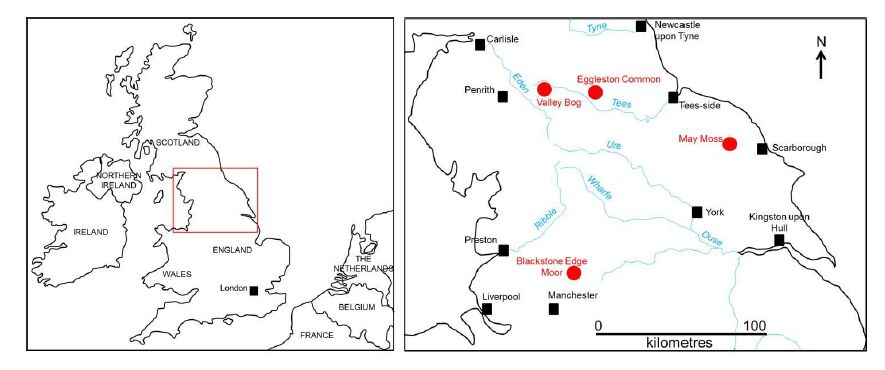
 DownLoad:
DownLoad: 